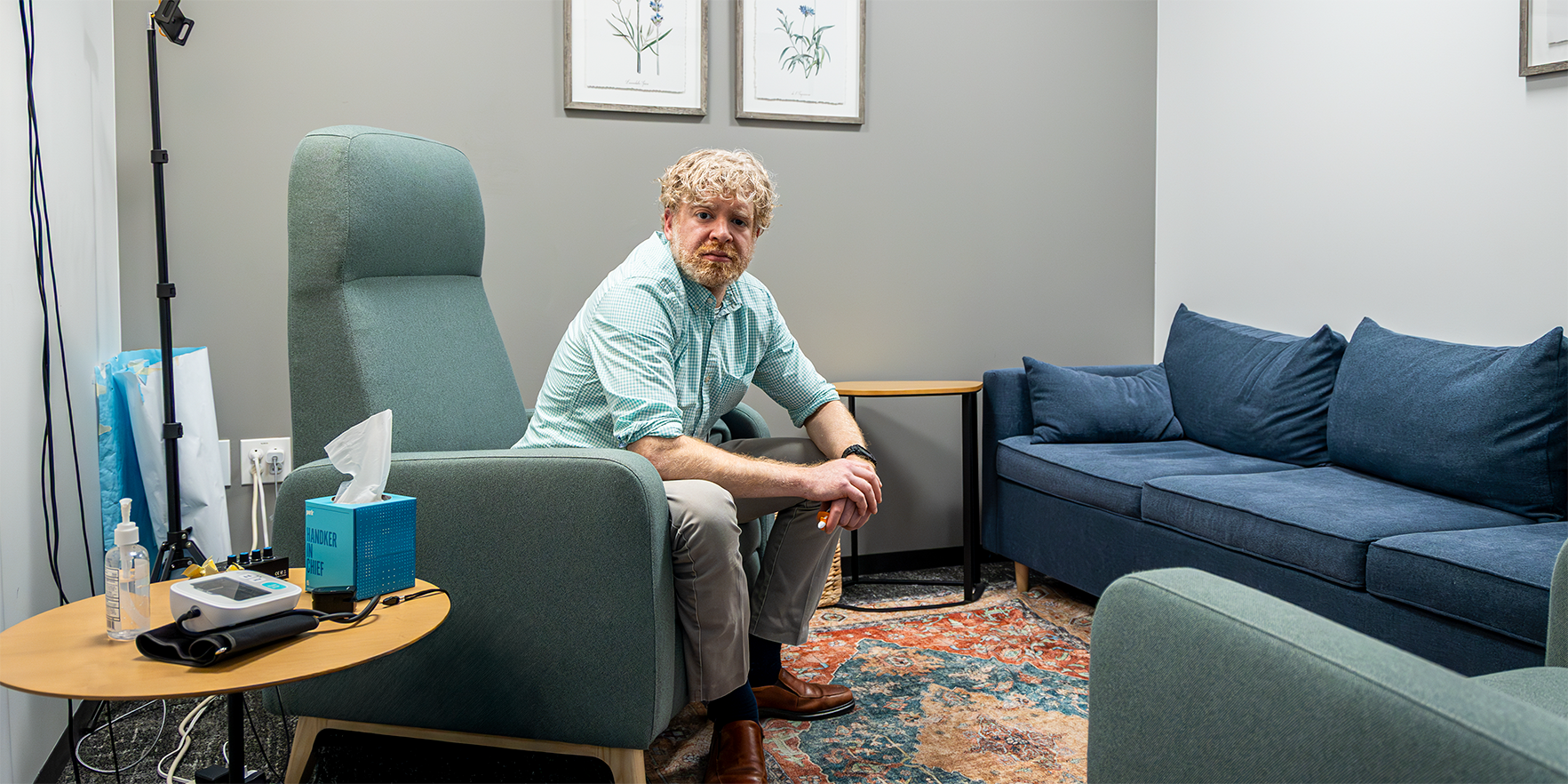With its curved nursing stations and faux stone pathways winding throughout brightly-lighted hallways, the new 40-bed behavioral health unit at UCHealth University of Colorado Hospital (UCH) represents a fresh focus on mental healthcare at the CU Anschutz Medical Campus.
The fifth-floor unit in the newly-opened 11-story tower helps fill an inpatient need for a growing number of suicidal and acutely ill mental health patients. A collaborative effort, the new unit is fueled by a $150-million UCHealth commitment to behavioral health and the expertise of the CU Department of Psychiatry.
“Someone who's seriously mentally ill is three times more likely to be in a jail or prison than they are to be in a hospital, which is a huge problem,” said Christopher James, MD, medical director of the UCHealth Behavioral Health Unit - University of Colorado and senior instructor in the CU School of Medicine’s Department of Psychiatry. “With the mental health crisis that's going on not just in this state, but around the United States, inpatient psychiatric beds are at a premium,” James said.
From failures of deinstitutionalization instigated during the civil rights movement to the current drug and mental health crises, multiple factors are behind the dearth of beds, which the facility helps to reduce. But the new UCH inpatient unit offers much more than beds.
Creative work involving minds from across campus went into the new unit, which is undergoing a staged opening. The top-grade facility was designed with the intention of treating patients wherever they are on their mental health path and ensuring their care through the end of their journey.
Beds in an interventional psychiatry suite stand ready to offer patients top-of-the-line treatments not available in many behavioral health units. Photo Credit: UCHealth/Sonya Doctorian
New unit stands out for medical treatment
Planners cut no corners on ambiance, safety and patient care when designing the unit, which consists of two wings and encompasses the entire fifth floor. The south wing caters to patients with severe mental illnesses who are still able to participate in therapy and groups, while the north wing cares for patients with severe psychological symptoms, such as psychosis or aggression.
As is common at the region’s largest academic medical campus, the UCHealth unit stands out for its vast resources accessible just down the hall or across the street. “We have the capability to take complex medical cases, which is a rarity,” James said.
Both wings have select beds with full medical capabilities, and the medical providers – consisting of the medical doctors, psychiatrists and resident psychiatrists provided by CU’s psychiatry department – have access to the full resources of the hospital, James said. Specialized nurses, therapists and social workers round out the holistic care the unit provides.
“Consultants from neurology, internal medicine, oncology, whatever we would need that exists in the rest of the hospital can be delivered to our unit,” he said. “Our patients can get both the psychiatric and medical care they need at the same time.”
Nationwide, patients are commonly denied access to needed inpatient psychiatric care because of other medical conditions facilities cannot address, James said. “We’ve already accepted a number of patients that have been refused from other hospitals in the area because we can provide for more needs.”
In-house ECT, esketamine centers elevate care
An attached interventional psychiatry suite will also take UCH patients’ quality of care to the next level. Electroconvulsive therapy (ECT) and esketamine (or S-ketamine) treatment centers, both novel, evidence-based therapies, are in the works for the suite.
“Esketamine treatments are really great for helping folks get through an acute suicidal episode,” James said. “On an inpatient psychiatric unit, we get a lot of those cases, folks that are very suicidal. Being able to offer them a treatment that is faster than anything else we have in the field to resolve that condition and get them back to their homes is going to be key.”
“Consultants from neurology, internal medicine, oncology, whatever we would need that exists in the rest of the hospital can be delivered to our unit. Our patients can get both the psychiatric and medical care they need at the same time.” – Christopher James, MD
ECT has one of the best response rates for severe treatment-resistant depression, can be used for high-risk patients such as pregnant women, and has beneficial effects in some psychotic illnesses, James said. The ECT center will open first, as early as July 31, and offer unique access to limited therapy, he said.
“People on my unit will be able to be rolled just down the hallway, get their ECT, and be rolled back onto the unit the same day.”
Both centers eventually will be open to outpatients, including those discharged from the unit who need continued sessions, which serves in lowering barriers to these really high-response rate treatments, James said.
State-of-the-art security measures put safety first
Creating a secure environment was top priority for designers, with the unit’s innovative safety measures beyond anything he’s seen, James said. “As you can imagine, many folks that are coming to us in acute mental health crisis are suicidal and maybe have active suicidal plans.”
No sharp corners or glass are used in furniture design or art frames. Windows are secured with a high-end security system, and nothing (no faucets, handles, furniture) can lend itself to a place to hang a ligature, James said.
All furniture is too heavy to throw, doors can be removed if they are barricaded, and the nurses’ stations are designed to have no blind spots, he said. “Every detail of this unit has been taken into account, preventing the risk or the capability of people to harm themselves or others.”
Art, natural light enhance healing environment
Safety measures did not come at the cost of an inviting, healing environment, James said. Curved furniture and floor patterns create a sense of flow in the units’ designs, and nature constitutes a theme throughout.
“The floor was meant to mimic kind of a walking path through nature,” James said, noting that a gray, curved pathway that looks like stones is surrounded by green patches to simulate grass. Floor-to-ceiling art of colorful Colorado landscapes adorn the walls, and the south unit includes a fitness center and indoor track.

Floor-to-ceiling wall art capturing scenes of Colorado’s stunning landscapes highlights a nature-focused theme on the new unit. Photo Credit: UCHealth/Sonya Doctorian |
Windows – “the most I've seen on any inpatient unit” – frame picturesque scenes and offer natural light. In both units’ dining areas, a west-facing wall of windows frame the Denver skyline with the mountain range as its backdrop, James said.
“It allows not only that engagement with the outside world in some way, but also the natural flow of light helps people to establish sleep patterns again and can lift moods. It can be therapeutic.”
Changing the ending by letting the healing begin
Having this unit on campus for patients in crisis can change their life paths, James said. “When someone comes into an ER in a mental health crisis, they're put into an environment where safety is the priority as opposed to treatment because it’s (supposed to be) a short-term environment,” James said.
The high-paced, noisy department coupled with a lack of mental health specialists can become anti-therapeutic for them. “And if you don't have beds available, you're essentially trapping people in this environment for longer periods of time than they need to be,” he said.
“So being able to provide a bed for them can get them out of that environment and on to the next step where they can actually start getting treatment. And that's where the healing can really begin.”
Photo at top: Curves provide safety and flow to the design of the fifth-floor unit in the brand-new Anschutz Inpatient Pavilion 3. Photo Credit: UCHealth/Sonya Doctorian

.jpg)


